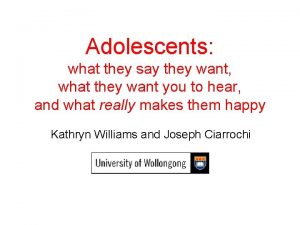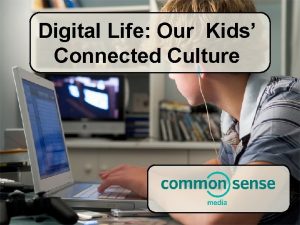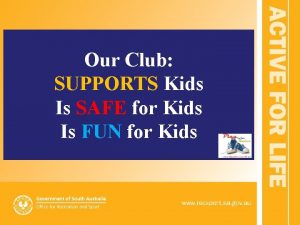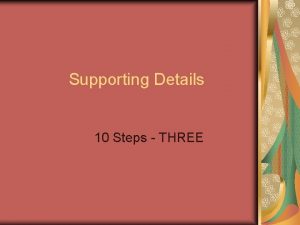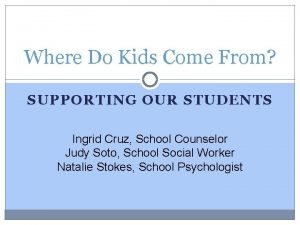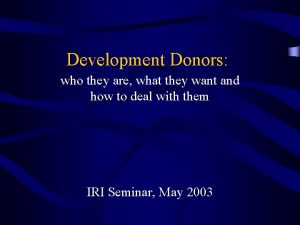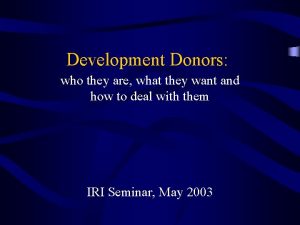Supporting Our Kids What they want What they
















- Slides: 16

Supporting Our Kids What they want. What they need. What we need to give them.

Outline ◦ A Kid’s World ◦ A Caregiver’s World ◦ A Context for Mental Health ◦ Understanding Stress and Anxiety ◦ Protective Factors ◦ A ‘Handy’ Model of the Brain ◦ Understanding ‘Flipped’ Lids ◦ How to Get Unflipped ◦ The Importance of Self-Care

A Kid’s World ◦ Limited opportunities for true rest ◦ Social Media (Perfect image vs Reality) ◦ Video Gaming (Designed stimulation) ◦ You. Tube/Media (Endless distraction) ◦ Overscheduled (Outcome vs True Play) ◦ Constant peer interaction ◦ Busy and stressed caregivers ◦ Confused expectations ◦ One the one hand – “Act more grown up. ” ◦ On the other hand – “You’re just a kid. ” ◦ Too much information (Internet, Social Media, Over-sharing)

A Caregiver’s World ◦ Limited opportunities for true rest ◦ Social Media (Perfect image vs Reality) ◦ Video Gaming (Designed stimulation) ◦ You. Tube/Media (Endless distraction) ◦ Overscheduled (Outcome vs True Play) ◦ Constant/Competing parenting advice (family, friends, ‘experts’) ◦ Busy and stressed caregivers ◦ Confused expectations ◦ One the one hand – “Go easy on them. ” ◦ On the other hand – “You’re too easy on them. ” ◦ Too much information (Internet, Social Media)

A Context for Mental Health Mental Illness/ Disorder (Anxiety 6 -10%, depression 4 -6%) Mental Problem Response to more serious external events (i. e. Moving, Loss of loved one) Mental Distress Something has changed/isn’t working Necessary experiences for growth & adaptation (i. e. Can’t find your keys, Not making the team, making a speech, big project ) “Life as usual” – No Distress/Problem/Disorder (i. e. Hanging out with friends, reading a book, walking the dog)

How Anxiety Works

Human beings naturally avoid experiencing pain (physical, emotional and psychological) The Truth about Stress and Anxiety HOWEVER: In order to grow and change we need to experience adversity and have our comfort zone stretched THEREFORE: Positive and Tolerable Stress are not inherently bad, it is our relationship to stress that can become problematic. Looking at stressful situations as a “challenge” and an “opportunity” activates a different set of responses in our system – those geared for growth versus harm

Stress: From Positive to Toxic: Prolonged; extreme (Rare) * in teenagers this could look like physical/sexual abuse; chronic neglect, violence; caretaker mental illness/substance abuse – without adequate adult support (complex outcomes) • DO NOT CONFUSE TOXIC STESS WITH POSITIVE OR TOLERABLE STRESS

Protective Factors: Helping kids manage hard things When children feel they matter to their parents, what other people think of them matters less. We don’t need to save our children from the wounding world they live in-this is impossible. It is our job to make sure we don’t send them into it empty handed. At the root of resiliency, emotional vulnerability, and soft hearts lies a simple truth: whoever a child gives their heart to has the power to protect it with their own. -Debbie Mac. Namara: Rest, Play, Grow

How To Be Your Child’s ‘Shield’ ◦ Come alongside your child’s upset with your physical presence i. e. tone of voice, the look in your eyes, physical closeness ◦ Be responsible for maintaining the relationship ◦ Create routines that foster connection (bedtime rituals, family mealtimes, helping with homework) ◦ Explicitly telling your kids how much you care about them and why (it sounds obvious but when we’re busy we often forget) ◦ Listen more, talk less ◦ Be curious about what’s not working-focus on consequences that connect when consequences are necessary

A ‘HANDY’ MODEL OF THE BRAIN

Understanding ‘Flipped’ Lids ◦ When lids are attached kids can be kind, show genuine interest in things, be patient, show empathy ◦ BUT kids are designed by nature to flip their lids on a regular basis and it’s the caregiver’s job to help put it back on ◦ When kids flip their lids it’s an opportunity for us to guide them through the process of becoming regulated again ◦ Kids fall apart where they feel the safest— consider it a compliment ◦ Regulate, reason-Bruce Perry

‘Unflipping’ Our Lids ◦ We are humans too and we have lids that flip ◦ It’s important to give ourselves permission to ”time out” ourselves before we try to respond to a situation ◦ When we need a time out it’s important not to give your child the message they are too much for you or that you don’t know how to handle them. ◦ Find a reason to back out of the situation (Just remembered you need to put on laundry, you need to go to the washroom, you need to make them a snack) ◦ It’s OK to tag team if that’s possible

We Can’t Give What We Don’t Have: Self -Care ◦To regulate yourself: ◦ Paced breathing—Breathe out longer than you breathe in ◦ Shock your system—splash some cold water on your face ◦ Notice 5 things you can see, 5 things you can hear, and 5 things you can physically feel ◦ Find your feet ◦ Remember what matters-–connecting to your values helps make tough times worth it

Resources Used in this Presentation ◦ Kids These Days by Jody Carrington ◦ Mental Health Literacy by Stan Kutcher (teenmentalhealth. org) ◦ Rest, Play, Grow by Debbie Macnamara ◦ The Hand Model of the Brain by Dan Siegel (youtube https: //www. youtube. com/watch? v=gm 9 CIJ 74 Ox w)

Other Helpful Resources ◦Anxious Kids Anxious Parents by Reid Wilson and Lynn Lyons ◦The Upside of Stress by Kelly Mc. Gonigal ◦The Whole-Brain Child by Dan Siegel
 Kids r kids west cobb
Kids r kids west cobb Money madness poem pdf
Money madness poem pdf Thinking affects our language which then affects our
Thinking affects our language which then affects our Our future is in our hands quotes
Our future is in our hands quotes We bow our hearts
We bow our hearts Our awareness of ourselves and our environment
Our awareness of ourselves and our environment Our census our future
Our census our future Awareness of ourselves and our environment is
Awareness of ourselves and our environment is Our census our future
Our census our future Is our awareness of ourselves and our environment.
Is our awareness of ourselves and our environment. Christ, be our light shine in our hearts
Christ, be our light shine in our hearts Our awareness of ourselves and our environment is called
Our awareness of ourselves and our environment is called Our life is what our thoughts make it
Our life is what our thoughts make it God our father christ our brother
God our father christ our brother Marcus aurelius our life is what our thoughts make it
Marcus aurelius our life is what our thoughts make it This is our book
This is our book Jordan 14
Jordan 14


















